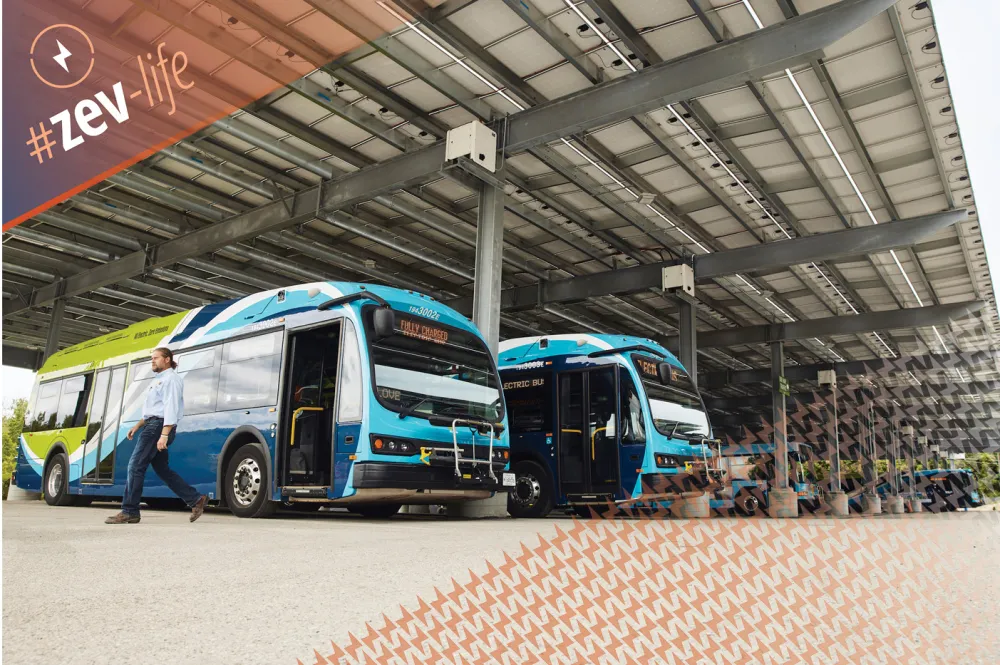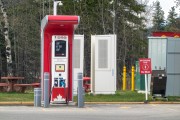The government of Canada’s recent Emissions Reduction Plan highlighted the importance of transitioning the transportation sector off fossil fuels. However, transitioning a fleet of combustion engine vehicles to those powered by electricity presents significant financial and technological challenges. Public departments and private corporations across Canada and the United States are now on the path to a green energy future, often with the help of partners who have the expertise, the shared values, and in some cases the capital, to assist them in making the switch. In this series, the Pembina Institute interviews organizations who have begun the process. This is the fourth entry in the series.
Like many businesses that consume large amounts of liquid fuel, the transit system for Montgomery County in Maryland, just north of Washington, D.C., is looking for ways to reduce its carbon footprint.
Calvin Jones, the division chief of fleet management services, stressed that both the Montgomery County council and its executive “view global warming as an existential threat.”
Read more from #ZEV-life
Purolator “steps up” to innovate for the climate
Clean garbage trucks? A municipality in Quebec is giving them a try
Flat-packing and ZEVs: IKEA helps consumers make low-GHG choices
The county’s action plan calls for a reduction in greenhouse gas emissions of 80 per cent by 2027, and 100 per cent by 2035. The transit system needs to switch to renewables at high speed.
But two obstacles made the transition difficult. First, both the vehicles and their charging infrastructure require large capital outlay. Second, electric fleets demand complex charging systems that require workers to have comprehensive knowledge of how they should be constructed and operated.
“We have technicians who know how to work on vehicles. However, with the newer technologies associated with charging, refuelling — they don’t have that internal expertise,” said Jones.
After researching business models and technological requirements, Montgomery Transit issued a request for proposals that eventually led them to AlphaStruxure, a joint venture of the Carlyle Group, one of the largest global asset companies, and Schneider Electric, a world leader in energy technology.
In what it calls the Energy-as-a-Service (EaaS) model, AlphaStruxure designs, builds, owns, and operates renewable energy systems, with no upfront costs to its customers.
That means, instead of paying upfront for the infrastructure, the transit system pays a monthly invoice, which reflects all the services and values that the integrated energy and charging system delivers including ongoing service and maintenance of the physical assets, the digital platform and a consumption-based charge for the electricity.
 “EaaS allows the county to focus capital deployment on the vehicles and fleet analytics to manage those vehicles,” said Nicole Geneau, senior vice president, development at AlphaStruxure. It “lets someone else come along and take the complexity and headache out of planning and installing infrastructure.”
“EaaS allows the county to focus capital deployment on the vehicles and fleet analytics to manage those vehicles,” said Nicole Geneau, senior vice president, development at AlphaStruxure. It “lets someone else come along and take the complexity and headache out of planning and installing infrastructure.”
Very quickly, Montgomery County has incorporated four electric buses into its fleet, and they expect another 10 to be delivered in mid-2022. The microgrid AlphaStruxure installed will be capable of supporting 70 buses altogether.
The Montgomery County Transit System had previously used a different alternative to diesel — compressed natural gas. From that experience, its managers learned they must think ahead to what the total fleet will look like when the transition is complete, and they knew they needed to build in redundancy, in case part of the system fails.
To address the need for redundancy and resilience, AlphaStruxure deployed a microgrid. It will be online in early fall and capable of generating 2 megawatts (MW) of solar power and 0.63 MW of natural gas–generated power in the first phase and a total of 1.8 MW of natural gas–generated power when fully completed in 2023. “Because they are able to meet their charging load with onsite resources, they avoid demand charges and they do not need to worry about the impact of time-of-use tariffs from the utility,” Geneau points out.
 The installation also included 4.3 MW of battery storage so the buses can be charged overnight with solar power generated that day, and they can be ready for use the next morning.
The installation also included 4.3 MW of battery storage so the buses can be charged overnight with solar power generated that day, and they can be ready for use the next morning.
Some sectors will benefit more from the EaaS model than others — the more energy required, the better the economics. Transit is one of the segments that can benefit the most. Electrifying buses is complex and requires collaboration: “The upfront process is extremely iterative as you’re creating highly bespoke solutions,” Geneau says.
AlphaStruxure and Montgomery County are bringing their complementary skillsets to the joint venture, knowing that together they can move Montgomery County’s buses off fossil fuel.
Sponsors
The #ZEV-life series is part of the Pembina Institute’s efforts to develop a strategy to transition medium- and heavy-duty vehicles to zero-emission.
This work is supported by the Pembina Institute’s Urban Delivery Solutions Initiative and:












